Island hopping in Greece is undoubtedly one of the best ways to explore this Mediterranean country’s beauty. It has estimated 1200 to 6000 islands, up to 227 of which are inhabited.
Every single one of them has its own charm and no matter what you are looking for when traveling – you’ll find it in Greece. From luxurious resorts and vibrant nightlife over pristine beaches and untouched nature to unique architecture and rich history.
It comes as no surprise that Greek island hopping is a very popular activity for locals and tourists from all over the world alike.
But even a lifelong vacation wouldn’t be enough to visit nearly half of the islands. With so many options, where do you begin? Well, don’t worry, we’ve got you covered. Here are the answers to all your questions.
Island Hopping In Greece – Things To Know Before You Go
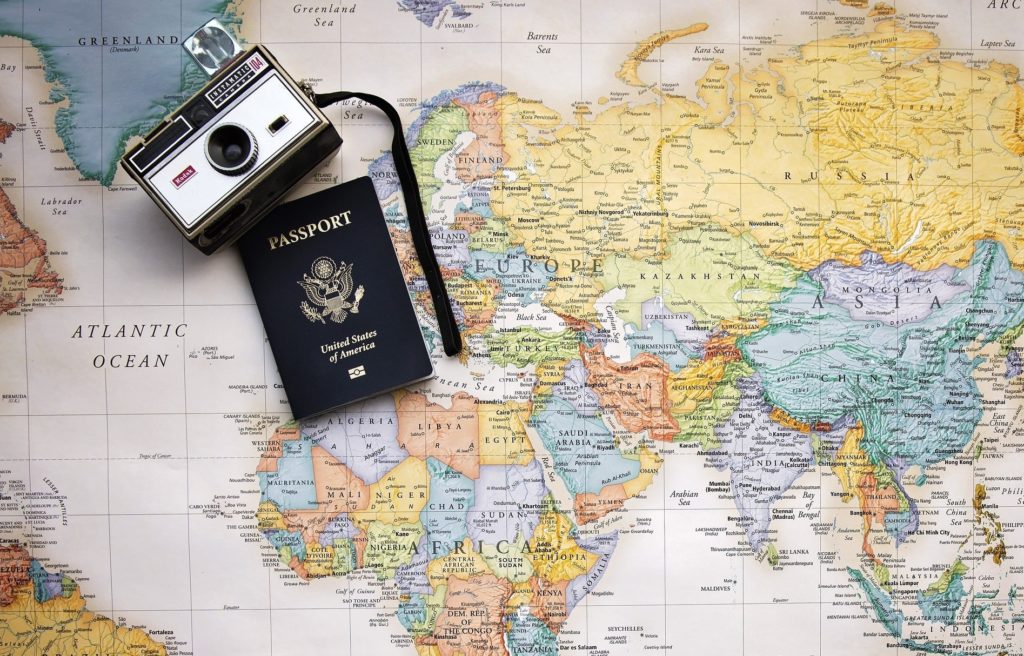
Island Hopping in Greece in a COVID-19 World
Since the country has opened its borders again, island hopping in Greece is possible in times of Covid-19. (There are a few exceptions though, depending on where you travel from.)
Check the following links to stay up to date and receive the latest information about the regulations regarding your country:
- Athens International Airport – Covid-19 Useful Information
- Protocol For Arrivals In Greece
- Ministry Of Foreign Affairs
- Greek Islands Booking
It goes without saying that general precautionary measures need to be followed strictly. Keep a distance to others, wear a mask, wash your hands and carry a hand sanitizer with you. (Seriously, don’t be that idiot who throws ‘COVID parties’.)
Also, be prepared for delays and cancellations of all sorts. Ferry schedules and routes may change. For more updated information, check out Ferry Hopper.
What To Pack

First things first – let’s take a look at what you need to bring.
Greece’s Mediterranean climate is hot and dry in summer and cold and wet in winter. In high season, temperatures can reach up to 40° C. If you plan to travel the Greek islands in summer (recommended), you want to wear loose and lightweight clothes and bring sun protection.
But no matter when you embark on your journey, there are a few things that no traveler should be without when island hopping in Greece.
(Solar) Power Bank
Unless you know how to navigate without GPS, a power bank will probably save you from missing your ferry (or the sunset from the best spot of the island) when your phone battery gives up after a full day of exploring.

Sustainable Water Bottle
The task is simple: Stay hydrated and avoid single-use plastic. The solution is a sustainable water bottle that keeps your drinks cool and protects you from drinking micro-plastics.
Usually, it is safe to drink the water from the tap in Greece. In case of doubt, use water purification tablets.

European Adapter

Unless you live in another European country, you’ll sooner or later need an adapter. Bring 2-3 to be on the safe side, they really don’t take much space.
Travel Towel

The moment I got myself a travel towel has literally changed my life. It’s light, easy to squeeze into any corner of your backpack and dries within minutes in hot weather. Really, it makes traveling that much more pleasant.
If you don’t have a travel towel yet, consider getting the eco-version made from recycled plastic bottles.
Waterproof Camera
The Greek seas are known for their crystal clear, warm waters that are ideal for diving and snorkeling adventures, as well as other water sports like kitesurfing, kayaking and sailing. Bring a waterproof action camera to record your favorite moments!

Hammock
Whether you are planning to go on a camping trip or prefer hotels and guesthouses, a travel hammock can increase the relaxation factor of your trip A LOT. Hang it up between pine trees in the mountains or by the beach and suntan, take a nap or enjoy the sunset with some Greek wine.

Other essentials are basic travel medicine (like Ibuprofen and Imodium), insect repellent and a Greek island travel guide (I recommend this one from Lonely Planet).
Where To Start
You can either start your island hopping adventure from the mainland or from one of the Greek islands. It all depends on what you’d like to see, how much time you’ve got and your travel style. But we’ll get to that a bit later.
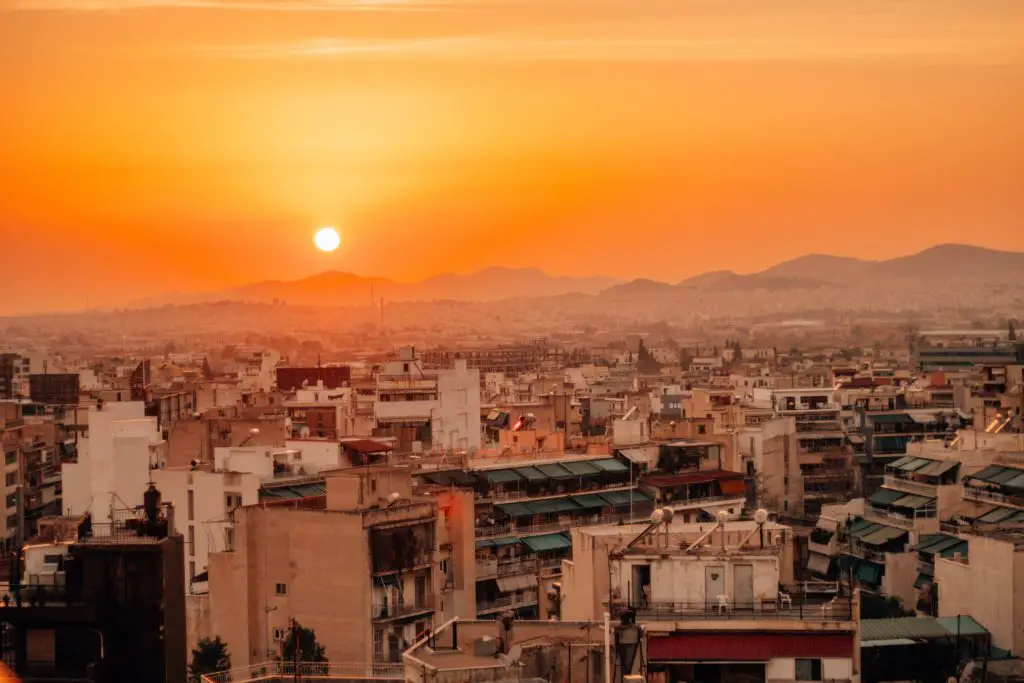
If you are based or arriving in Athens, your starting port will most likely be Piraeus. It is the capital’s main port.
Other options are:
- Rafina
Athens, second biggest port - Lavrio
Athens, smallest port and furthest away - Agios Konstantinos
ferries to the Sporades - Thessaloniki
ferries to some of the larger Aegean islands - Kavala
principal seaport of Eastern Macedonia, ferries to Athens and some Aegean island - Mantoudi
small harbour on Euboea - Volos
midway on the Greek mainland, ferries to the Sporades islands - Patras
large port on the west coast, ferries to Italy and the Ionian islands - Igoumenitsa
one of the largest passenger ports of Greece, ferries to Italy and the Ionian islands
If you would like to take a plane directly to one of the islands, you can choose between the following international airports:
- Crete
Heraklion International Airport “Nikos Kazantzakis”
Chania International Airport “Ioannis Daskalogiannis” - Corfu
Ioannis Kapodistrias International Airport - Kefalonia
Kefalonia International Airport Anna Pollatou - Zakynthos
Zakynthos International Airport “Dionysios Solomos” - Kos
Kos International Airport - Lemnos
Lemnos International Airport “Hephaestus” - Lesvos
Mytilene International Airport “Odysseas Elytis” - Samos
Samos Aristarchos International Airport - Rhodes
Rhodes International Airport “Diagoras” - Karpathos
Karpathos International Airport - Santorini
Santorini (Thira) International Airport - Skiathos
Skiathos Alexandros Papadiamantis Airport
In case you want to avoid planes, travel by car, or just enjoy boat rides, you can also take ferries from other European countries:
- Italy
From Ancona, Bari, Brindisi or Venice (get more information here) - Albania
From Sarande (get more information here) - Turkey
From Ayvalik, Cesme, Kusadasi, Turgutreis, Bodrum, Marmaris, Fethiye or Kas (get more information here)
Best Time For Greek Island Hopping
In general, the time between late April and early November is ideal for island hopping in Greece. July and August are the hottest months.
Two of the most popular islands in Greece, Crete and Santorini, are year-round destinations. You can expect enough accommodations and restaurants to be open in winter. Other places, however, turn into ghost towns in off-season, which means you probably won’t find establishments that are open for business.
If you are travelling on a budget and/or would like to escape the tourist crowds, the best time to visit Greece is March, April, May, October and November.
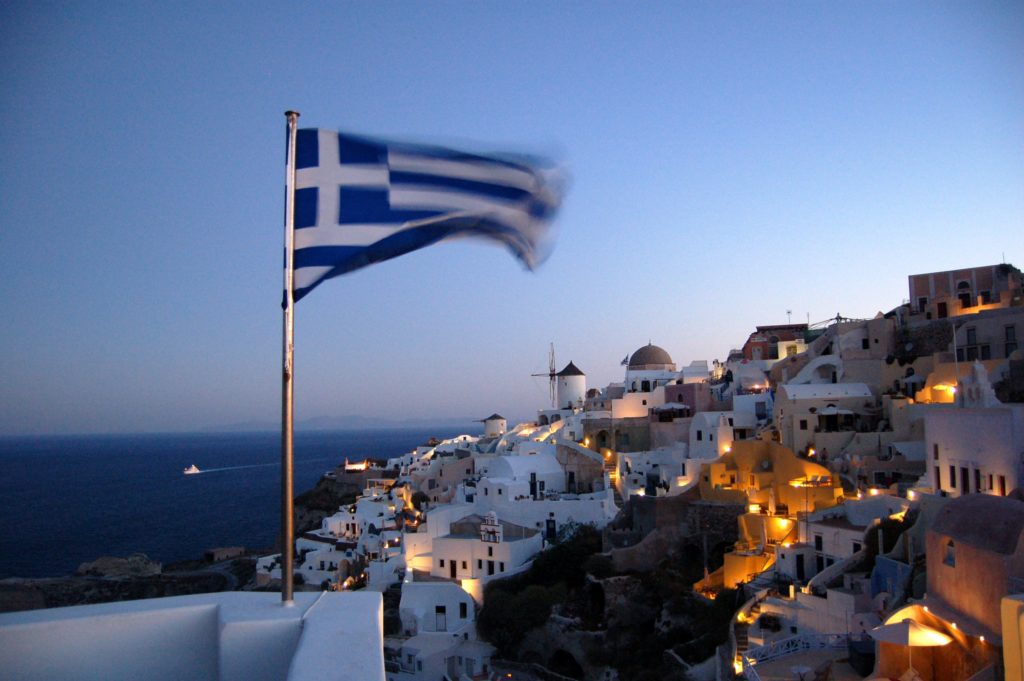
In case you are planning to do Greek island hopping in high season, I recommend to book hotels in advance (on the most popular islands).
Moreover, there are a few days per year that will cause crowded ports, ferries and islands.
Greek Holidays (Book Your Ticket In Advance)
- Greek Easter (mainly Thursday and Friday before the Easter weekend. The next Orthodox Easter will take place on 2 May 2021.)
- Agios Pnevmatos (Holy Spirit), which takes place 40 days after Easter.
- The last few days of July and almost the whole month of August, which is when most of the locals go on holiday.
You can find a list of all holidays in Greece this year here.
Getting Around – Ferries 101
If you are a slow traveler (like us), you probably enjoy long ferry rides and see them as part of the journey. There is nothing more relaxing than sunbathing on deck while planning your upcoming island adventures, enjoying the views with a cold Mythos beer or just falling asleep to the sounds of the sea.
But of course there are times when a faster alternative comes in handy. Yet, we believe that taking planes from island to island is not necessary (even, if you are on a tight schedule. And trust me, island hopping in Greece is best enjoyed when you aren’t).
Do the planet a favor and skip the flights. Instead, chose between the following fast ferry and slow ferry options.
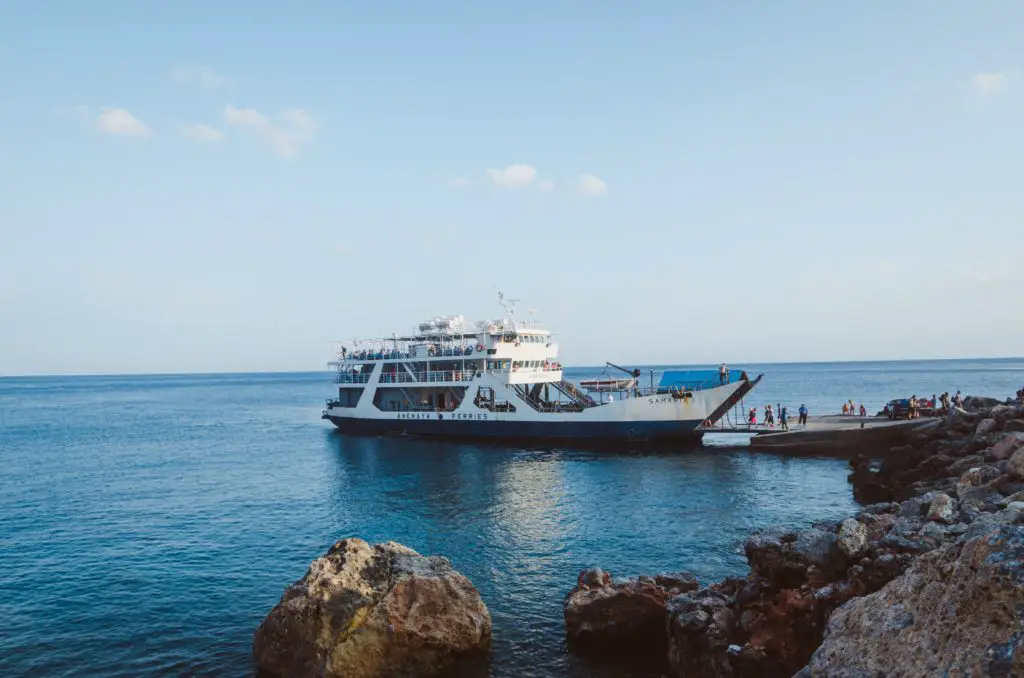
Slow Ferry vs. Fast Ferry
Depending on where you’re headed you may be able to choose between a fast ferry and a slow ferry.
Slow Ferry
| PRO | CON |
| best to avoid seasickness | take longer than fast ferries |
| cheaper than fast ferries | |
| decks are open | |
| most reliable option |
Fast Ferry
| PRO | CON |
| faster than slow ferries | not ideal for seasickness |
| often more modern with amenities on board | decks are sometimes closed (especially in bad weather) |
| may be canceled due to bad weather | |
| more expensive than slow ferries |
This is just a rough overview. Your ferry ride experience also depends on a few other factors, like size and general condition of the boat.
Good To Know
Blue Star Ferries is the biggest ferry company in Greece. They offer high-speed catamarans and super ferries, as well as much older slow ferries, and cover the majority of routes between the Greek islands.
Flying dolphins are small high-speed boats that usually go the short routes between the mainland and the closest islands.
The following platforms are useful when planning and booking a ferry ride.
Weather and ferry schedules can change (last minute). Strikes are also not uncommon (find the latest information on strikes here). It is advisable to stay flexible and prepared for possible delays or cancellations.
When it comes to ferry tickets to more popular islands, the worst that can happen to you is that there is a delay or you have to take the next ferry. If you are planning to visit an island with less frequent ferry traffic, I recommend you call the ferry company before you book your ticket online to be on the safe side.
If the ticket that you have booked online is not an e-ticket (if it doesn’t have a bar code, it most likely is not), you need to pick up the real ticket at the harbor. You can usually get it around 30 to 60 minutes before departure. Make sure you arrive early enough, as the main harbors are quite large and it can take some time until you’ve figured out where you need to be.
How much does island hopping in Greece cost?
The rule of thumb when it comes to ferry ticket prices is: the slower, the cheaper.
The budget-friendly option is to book economy tickets. That means you won’t have a cabin on overnight trips and will spend the whole ride on deck, on airplane seats or the floor inside. High-speed ferries charge around 30 % – 50% more for an economy ticket than the slower boats.

A plus is that you don’t need to buy the ticket in advance. With a few exceptions (mentioned above), economy tickets are usually not sold out and can be purchased at the harbor.
If you want to make sure that you have a seat or cabin, book in advance.
Island Hopping Ferry Pass
If you have heard of Interrail before, you probably associate it with train rides through Europe. What most people don’t know is that they also offer two different Greek island passes.
You can choose between the 6 Trips Pass (which includes two international trips between Italy and Greece and four domestic trips to Greek islands) and the 5 Trips Pass (which includes five domestic trips within Greece).
Read more about the Interrail Ferry Passes here.
Which Greek Islands Do You Want To Visit?
This is the part where planning your Greek island hopping adventure gets really exciting – choosing the islands you’d like to explore.
Keep in mind, Greece has hundreds of islands and you can’t visit all of them. Ideally, you pick islands that are close to each other. But first, let’s see what we are working with here.
There are eight main island groups (and single islands) in Greece:
- Aegean islands
- Crete
- Cyclades
- Dodecanese
- Euboea
- Ionian islands
- Saronic islands
- Sporades

North Aegean Islands

Compared to other areas, like the Cyclades, the North Aegean islands are less crowded and perfect for travelers who like to explore off the beaten path. Each island has its own identity, with a rich cultural heritage, picturesque beaches and stunning nature.
Location:
Aegean Sea, close to Turkey
Islands:
Samos, Ikaria, Chios, Lesbos, Lemnos, Agios Efstratios, Psara, Fournoi Korseon, Oinousses, Samothraki, Thassos
How to get there:
Lesbos has an international airport. Thassos is only a short ferry ride away from Greek mainland. Lesvos, Samos and Chios are connected with daily ferries, as well.
Distance from mainland:
- Piraeus – Chios: 9:25 h – 10:55 h
- Piraeus – Samos: 9:20 h – 10:30 h
- Piraeus – Lesvos: 11:45 h
- Keramoti – Thassos: 0:35 h
Activities for your bucket list:
CHIOS WEATHERImportant To Know:
Since 2015, thousands of refugees have been arriving on the Aegean islands after fleeing their war-stricken home countries (mainly Syria, Afghanistan and Iraq). Especially Lesvos and Chios are mentioned by international media outlets in the context of the crisis and inhumane conditions in the refugee camps.
When you travel to the Northern Aegean islands, don’t be an ignorant tourist. Inform yourself before you go and consider volunteering and/or donating money (the latter obviously also if you don’t travel to the Aegean islands). Especially now during the Corona crisis, support is needed.
Find more information on the refugee situation in Greece here. Learn how you can help here.
Cretan Islands

Crete is the largest and most populous Greek island and the fifth largest island in the Mediterranean sea (after Sicily, Sardinia, Cyprus and Corsica). Its landscape is mostly characterized by high mountains, which makes it a paradise for outdoor lovers. Crete furthermore contributes significantly to Greece’s cultural heritage and economy.
Pro Tip: When it comes to island hopping in Greece, Crete is often combined with other large islands like Santorini and Mykonos, while lots of beautiful smaller islands surrounding Crete are overlooked. Gavdos for example is the southernmost point in Europe and has one of the most beautiful beaches of the continent (Agios Ioannis or St. John).
Location:
Southern part of the Aegean sea, separating it from the Libyan sea.
Islands:
Main island: Crete
Surrounding islands (sample): Gramvousa, Elafonisi, Chrysi, Paximadia, Dionysades, Gavdos
How to get there:
You can reach the ports of Crete from many islands of the Dodecanese and Cyclades, such as Santorini, Paros, Naxos, Mykonos, Amorgos, Milos, Kythera, Karpathos, Rhodes and Kos.
Distance from mainland:
- Piraeus – Kissamos: 10:25 – 12:20 h (by car ferry, once a week)
- Piraeus – Chania: 6:30 – 9 h
- Piraeus – Heraklio: 8:45 – 17:41 h (by car ferry, once a week)
Activities for your bucket list:
CRETE WEATHERCyclades

When it comes to island hopping in Greece, the Cyclades are the most famous location. Known as a paradise on earth, this group of islands with gorgeous beaches, white-washed traditional houses and breathtaking views is a destination for millions of Greek and foreign travellers every year.
The name “Cyclades” refers to the circular shape the islands form around the sacred island of Delos.
Location:
Southeast of the Greek mainland in the Aegean Sea, bounded to the south by the Sea of Crete.
Islands:
In total: around 220
Main islands: Amorgos, Anafi, Andros, Antiparos, Delos, Ios, Kea, Kimolos, Kythnos, Milos, Mykonos, Naxos, Paros, Folegandros, Serifos, Sifnos, Sikinos, Suros, Tinos, Santorini
How to get there:
Except Andros, which is connected to Rafina, and Kea, which you can reach from Lavrion, the main islands of the Cyclades are accessible via ferry from Piraeus.
Santorini has daily ferry connections to Paros, Naxos, Crete
Distance from mainland:
- Piraeus – Santorini: 12:15 – 17:40 h
- Piraeus – Mykonos: 9:45 – 12:45 h
- Rafina – Mykonos: 4:30 h
- Rafina – Andros (Gavrio): 1:05 – 1:55 h
- Lavrio – Kea: 1:30 h
- Piraeus – Paros: 2:50 h
- Paros – Naxos: 0:35 h
Activities for your bucket list:
SANTORINI WEATHERDodecanese Islands

The Dodecanese islands are more quiet than others (e.g. the Cyclades) and known for their medieval architecture and the peaceful beaches.
The name Dodecanese means “twelve islands” and was established during their long period of Turkish administration. Today however, there are 15 main islands that make up this island group.
Location:
southeastern Aegean Sea
Islands:
15 larger islands: Rhodes, Kos, Patmos, Agathonisi, Astypalaia, Chalki, Kalymnos, Karpathos, Kasos, Leipsoi, Leros, Nisyros, Symi, Tilos, Kastellorizo
plus 150 smaller islands: e.g. Alimia, Arkoi, Farmakonisi, Gyali, Kinaros, Levitha, Marathos, Nimos, Pserimos, Saria, Stronyli, Syrna, Telendos
Inhabited: 26.
How to get there:
There are daily ferries going from Piraeus to Rhodes. Rhodes is connected daily to Patmos, Leros, Kalymnos and Kos.
Distance from mainland:
- Piraeus – Rhodes: 14: 35 h – 1 day, 9 h
- Piraeus – Kos: 11:15 h
- Piraeus – Kalymnos: 8 – 10:45 h
- Piraeus – Tilos: 15:50 h
Activities for your bucket list:
RHODES WEATHEREuboea
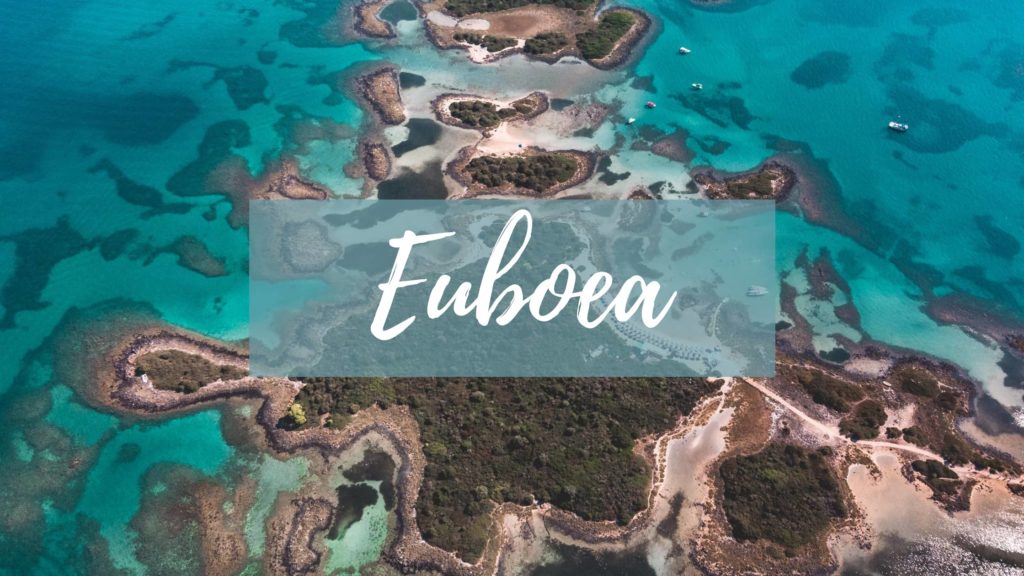
Euboea (also known as Evia) is Greece’s second largest island after Crete. It is separated from Greek mainland by the Euripus strait, which is only 40 meters wide at its narrowest point.
Divided in South, North and Central Evia, the central part is easily accessible from the mainland. From there you can travel to the forested north and the barren south.
Location:
Islands:
Main Island: Euboea
The Euboea regional unit also inlcudes: a 260 km² area on the Greek mainland
How to get there:
There are two bridges connecting the island to the cities of Thebes and Athens. Therefore, Euboea is the only Greek island that is accessible via land. You can take a bus or the car to Euboea or alternatively (of course) go by ferry.
Distance from mainland:
- Rafina – Marmari: 1 h (by ferry)
- Agia Marina – Nea Styra: 0:45 h (by ferry)
- Arkitsa – Edipsos: 0:45 h (by ferry)
- Oropos – Eretria: 0:20 h (by ferry)
- Athens – Nea Artaki: 1:20 h (by car)
Activities for your bucket list:
SKYROS WEATHERIonian Islands
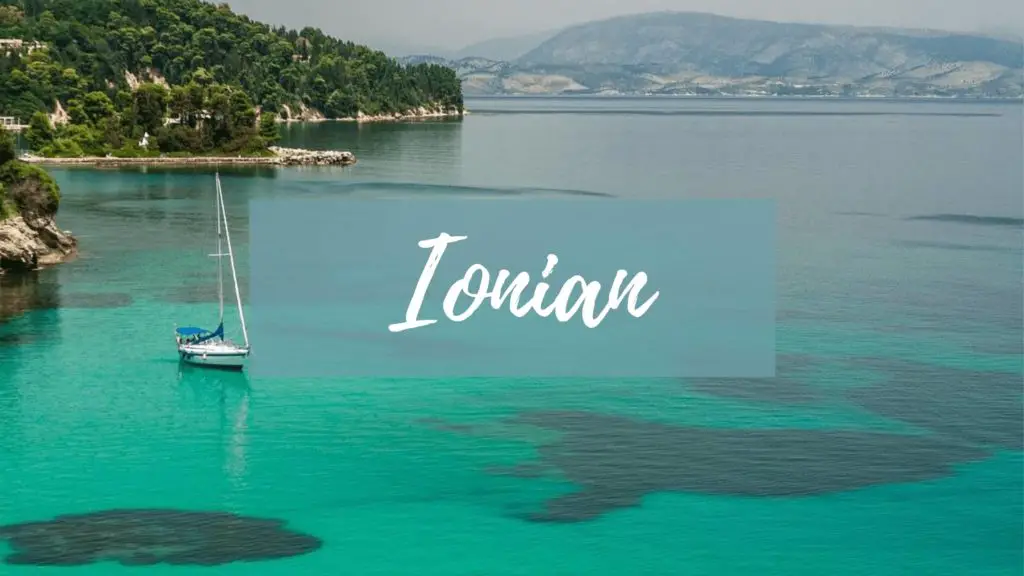
The Ionian islands are known for their steep coastlines, high mountains and sandy shores. A must-see destination for everyone who enjoys dramatic sceneries, outdoor adventures and water sports.
Location:
6 out of 7 islands are located off the west coast of Greece, in the Ionian Sea. (Khytira is off the southern tip of the Peloponnese)
Islands:
Corfu (Kerkyra), Paxos (Paxi), Lefkada, Ithaki, Kefalonia, Zakynthos, Khytira
How to get there:
Direct ferries to the islands leave daily, mostly from Igoumenitsa. There is also a ferry that leaves from Patras, which takes much longer than the others. It connects the island with ports in Italy (Venice, Bari, Ancona).
Lefkada is connected to the mainland by a long causeway and floating bridge.
Note: There is no ferry connecting Athens to Corfu.
Distance from mainland:
- Igoumenitsa – Corfu: 1:30 h
- Igoumenitsa – Paxos: 1:30 h
- Patras – Kefalonia: 3:15 h
Activities for your bucket list:
CORFU WEATHERSaronic Islands

Often overlooked when island hopping in Greece, the Saronic Islands are the closest to Greek mainland. Visitors (locals and foreigners alike) come here to enjoy the Greek lifestyle, traditional architecture and great food.
Location:
Off the mainland and Peloponnese peninsula in the Aegean’s Saronic Gulf
Islands:
Aegina, Agistri, Salamis, Poros, Hydra, Dokos
How to get there:
There are many boats (mainly Flying Dolphin ferries) going from Piraeus to the islands on a daily basis.
Distance from mainland:
- Piraeus – Aegina: 0:40 – 1:15 h
- Piraeus – Hydra: 1:40 – 2 h
- Piraeus – Poros: 0:55 – 2:40 h (by car ferry)
Activities for your bucket list:
AEGINA WEATHERSporades
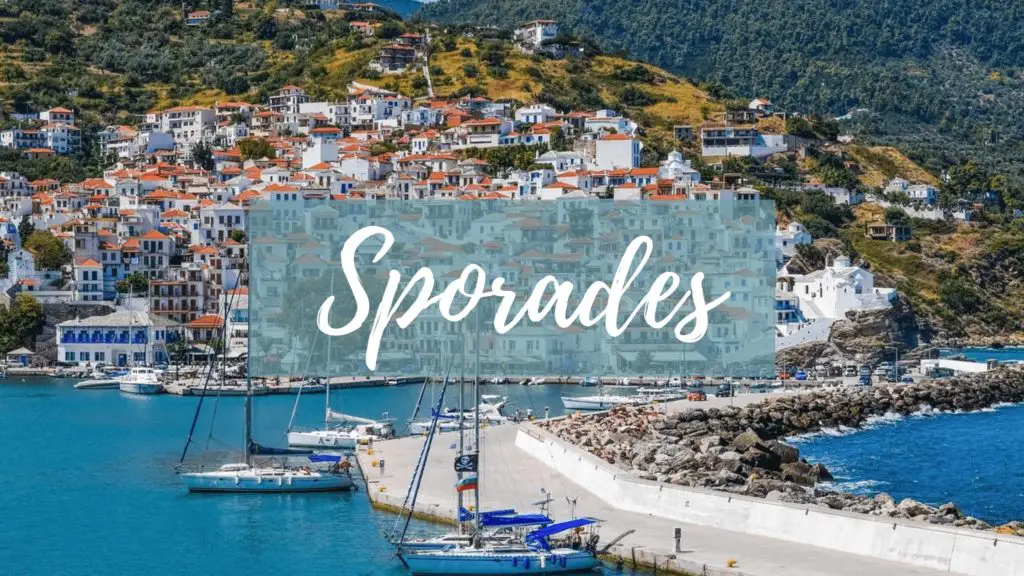
“Sporades” means “those scattered”. The islands are the remains of a mountain range that was detached from mainland in a geological convulsion.
Because they are located on a traditional trade route between the Black Sea and the Mediterranean, they used to be targets of pirates on a regular basis. Thus, there are not many ancient remains and archaeological sites on the Sporades.
Instead, this is the place to be for scenic hikes, postcard-worthy beaches and crystal-clear waters.
Location:
Aegean Sea, northeast of the island of Euboea
Islands:
In total: 24
Inhabited: Alonnisos, Skiathos, Skopelos, Skyr
How to get there:
Skiathos has an international airport. There are daily ferries from Agios Konstantinos (about 150 km from Athens) to Alonnisos, Skiathos and Skopelos.
Distance from mainland:
- Agios Konstantinos – Skiathos: 3:30 h
- Mantoudi – Skopelos: 1:20 h
- Agios Konstantinos – Skopelos: 4:15 h
- Mantoudi – Alonnisos: 2:20 h
Activities for your bucket list:
SKIATHOS WEATHERGreek Island Hopping Routes
Which routes you take and which islands you combine on your island hopping adventure depends on a few factors.
As previously mentioned, it generally makes sense to focus on one region instead of several islands that are scattered throughout the Greek seas. The more time you’ve got, the more places you can visit (obviously). However, it can be much more relaxing (yet exciting at the same time) to chose only a handful destinations and spend more time exploring each one than to rush through half of Greece’s islands without really being able to take in the experiences.
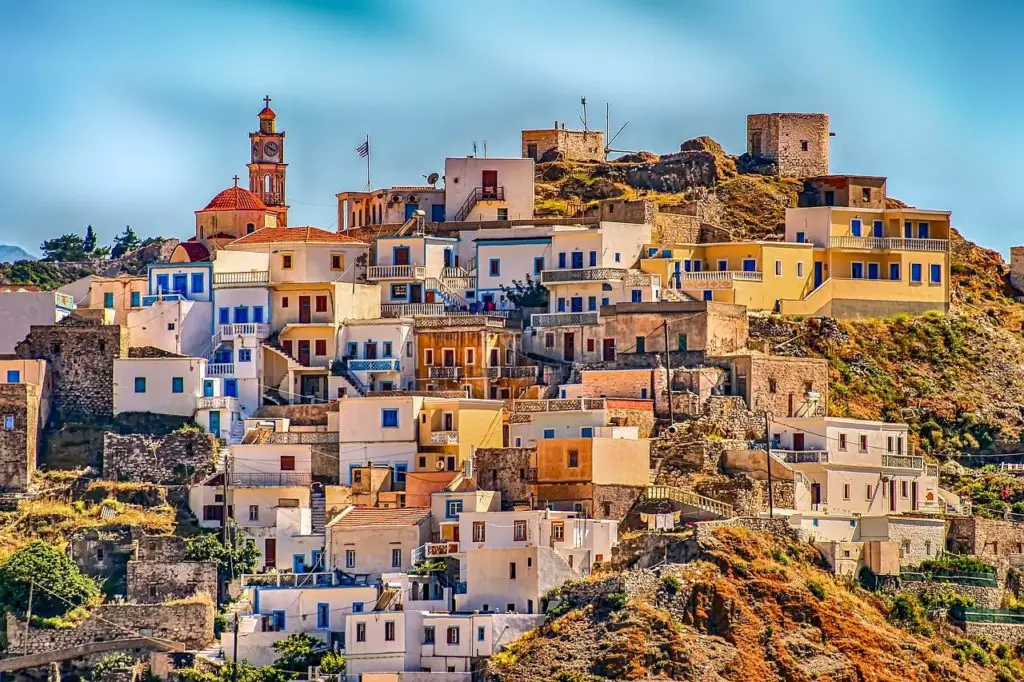
General Guidelines And Tips For Island Hopping In Greece
- Choose your favorite island first and build your island hopping trip around it. For example, if you definitely want to see Santorini, pick one or two other islands in the Cyclades to add to your itinerary.
- If you are based on the mainland and don’t have much time, do your research about islands that are closer to your nearest port first. It would be a waste of time to plan a weekend on Rhodes, just to spend half of it on a ferry.
- Think about what you’d like to see and do while island hopping in Greece. Are you an adrenaline seeker, party animal, beach bum or history enthusiast? Different destinations are suitable for different activities (but don’t worry, there’s an island for every kind of traveler!).
- If you are traveling in high season, be prepared to share Greece’s beauty with tons of tourists from all over the world. In order to avoid the crowds, travel in shoulder season or plan your trip around less popular places.
Greek Island Hopping Epi-Centers
Now that we have an overview of the different island groups and their highlights, let’s get more specific and plan your trip.
In order to understand which islands are easy to combine, we first need to take a look at the Greek ferry system.
You can compare it to a bicycle wheel, where the center of the wheel (hub) is connected to all the spokes that reach out. When it comes to island hopping in Greece, this means that Athens is the main hub.
However, there are a couple of island hopping epi-centers throughout the Greek seas. They are larger islands with many ferry connections in different directions.
- North Aegean: Samos, Lesvos
- Cyclades: Syros, Naxos
- Dodecanese: Rhodes, Kos
- Ionian: Igoumenitsa, Patras (mainland)
- Saronic: Piraeus (Athens, mainland)
- Sporades: Skitahos
In general, the most popular island groups, Crete, the Cyclades and the Dodecanese are well connected, especially in the summer months.
Which Greek Islands Are Best For You?

Best For: Short Trip
Aegina, Agistri and Hydra are very close to the Greek mainland and accessible within less than an hour. So, even if you only have a weekend, you’ll get a taste of Greek island life without wasting too much time getting from A to B and back.
Best For: Luxury Leisure
Santorini and Mykonos in the Cyclades are famous for their cosmopolitan atmosphere and fancy nightlife. Combined with Paros and Naxos, you can spend two weeks recovering on pristine beaches from sunset drinks with a view.
Best For: History
Rhodes and Kos are two of the Greek islands that are most famous for their history. If you have got enough time, definitely also add Crete to your history itinerary.
Get inspired: History of Rhodes, Kos, and Crete
Best For: Outdoor Sports
Hiking
In general, island hopping in Greece is a great activity for everyone who enjoys hiking in stunning nature. While you will probably find great hiking trails on almost every island, there are a couple of destinations that should be on every outdoor enthusiast’s bucket list. They include Lesvos, Samothraki, Crete, Paros, Naxos, Andros, Corfu and Sifnos.
Water Sports
Kitesurfing and windsurfing while island hopping in Greece is best enjoyed on Paros, Antiparos, Rhodes, Kos, Naxos, Limnos, Karpathos and Lefkada.
Ikaria, Kos, Limnos, Karpathos, Crete and Tinos are great for surfing.

A few of the best Greek islands for diving are Alonnisos, Chios, Crete, Lesvos, Santorini and Mykonos.
Climbing
Greece has become one of Europe’s best rock climbing destinations. Thanks to its rocky landscape, curious geological formations and the temperate climate, you can climb year-round. Some of the best Greek islands for climbing are Kalymnos and Crete.
Read more: Eco-Friendly Activities While Island Hopping In Greece
Best For: Unspoiled, Quiet Islands
In general, most of the Northern Aegean islands are rather secluded and free from mass tourism. Lemnos, Samothraki and Ikaria are just a few examples.

Karparthos, Astypalea and Tilos (Dodecanese), as well as Sikinos (Cyclades) are also often overlooked by the crowds, yet have much to offer.
Being the largest out of all the Greek islands, Crete has a lot of unspoiled corners and untouched areas that are ready to be explored by you (and only you).
Best For: Camping
With golden beaches and verdant pine forests, Greece is one of the best places for camping in Europe. Especially Naxos, Paros, Crete, Amorgos and Skiathos are very popular islands among alternative travelers.
Wild camping is officially not allowed in Greece. If you find a secluded area away from nature reserves, archaeological sites and tourist hot spots however, you could theoretically get away with it (You didn’t hear this from me, though).
Island Hopping In Greece On A Yacht
Let’s face it – there are not many better alternatives to sailing a yacht when it comes to island hopping in Greece. It allows you to explore hidden bays and untouched beaches that are cut-off from the public.
Sailing the Greek islands is not the cheapest option but definitely worth it (if you don’t get seasick easily).
For more information and sailing inspiration, check out the following websites:
- Greece sailing tours on Intrepid
- The Yacht Week Greece
- Jack & Jenny
- Sailing tours on G Adventures

How To Hitchhike Boats While Island Hopping In Greece
Sailboat hitchhiking basically means that you spontaneously crew on a boat. It gives you the opportunity to learn how to sail and travel around sustainably while helping out the captain with all kinds of work aboard, money or just good company (most of the times it’s a combination of all).
So far so good. Hitchhiking a sailing boat is not as easy as it sounds though, and only partly comparable to the ‘classic’ hitchhiking as we now it. Just holding your thumb out at the next best harbor is not gonna do the job.
There are three main ways of finding a boat for island hopping in Greece:
- Use your personal network to get the word out (works best if you’ve already got some sailing experience).
- Go dock walking and make friends in the harbors.
- Use the internet.
Each option has pros and cons and it’s up to you to figure out which one you prefer. The more different approaches you try, the higher are your chances of eventually finding the perfect match.
The following platforms can help you get started:
- findacrew.net
- Crew Bay
- Cruiser Log
- Facebook: Mediterranean Sailing Crew
- Ocean Crew Link
- Couchsurfing groups
Find more information on how to hitchhike sailing boats on theoceanpreneur.com
Accommodation

Spontaneity can make island hopping in Greece a lot more exciting. When it comes to accommodation however, you should do some research in advance. Not all of the islands provide hostels and if they do, they are booked out quickly in summer. You can use Hostelworld to find out which islands have hostels.
If you are traveling with two or more people, check AirBnB or look for B&Bs and hotels. There are several great green hotels throughout the Greek islands. Those accommodations are environmentally sustainable and have reduced their impact on their natural surroundings.
Booking.com
A Brief History Of Island Hopping In Greece
Modern travellers have been hopping from Greek island to Greek island since the 1960s. Island hopping in Greece became very popular as a destination for hippies, as well as tourists on a higher budget, mainly visiting Mykonos and Santorini.
The more frequent traffic in the Aegean sea led to the development of the ferry routes and several tourist accommodations. The hub and spoke system has become more elaborate within the last couple of years. Today, tourism is the cornerstone of almost every Greek island.
Greece is one of the most visited countries in Europe and even the world. In 2018, about 32 million visitors have traveled to the Mediterranean paradise. Santorini is the most popular island, followed by Crete, Corfu, Rhodes and Mykonos.
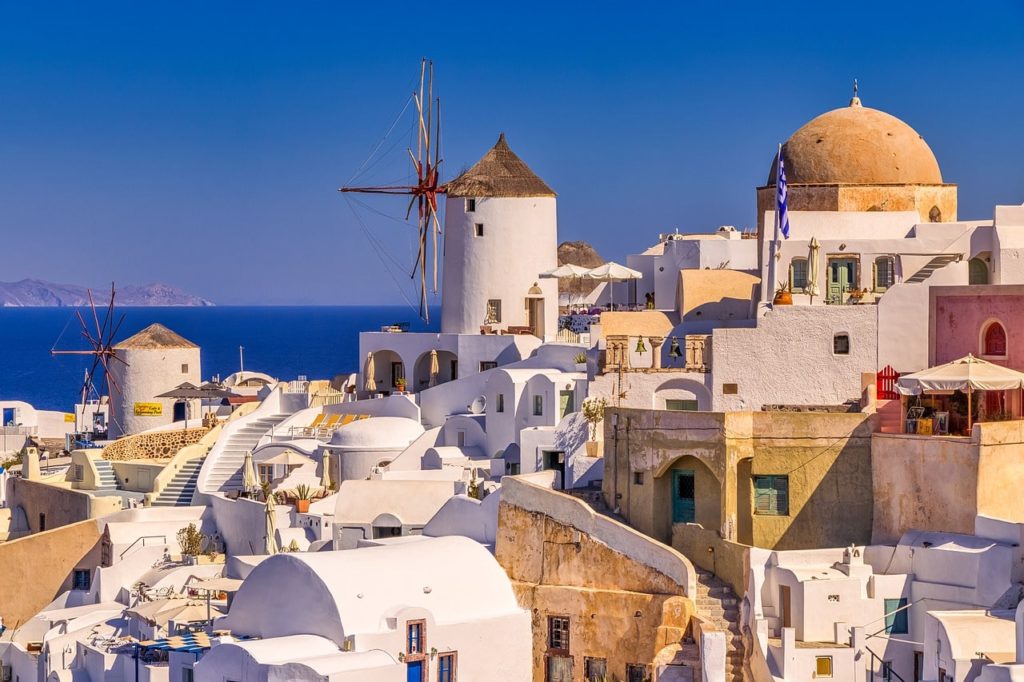
I hope you found this article helpful or just enjoyed daydreaming about island hopping in Greece a bit. If you have any further questions or can add value to this post, feel free to contact us in the comment section below.

Abel
Thursday 30th of July 2020
Excellent guide to Island hopping in Greece. For my experience when I traveled through Greece is to actually start the trip in Crete as it will give you an opportunity to discover the history of Greece. Furthermore for Mykonosit it is recommended to stay in the opposite side of the Island, much cheaper and some lovely local traditional restaurants in the little harbours. Also access to private beaches. Best to hire on of the buggies to travel with. The sunsets in Santorini is magical. Best to book in on of the boutique hotels on the rim of the Island.